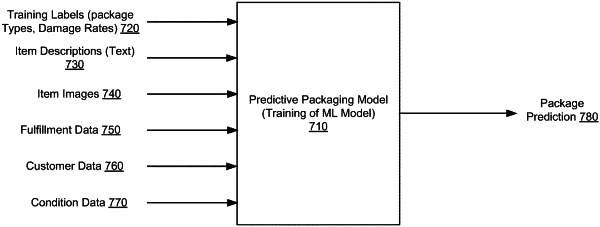| CPC G06Q 50/28 (2013.01) [G06F 16/2379 (2019.01); G06F 16/24 (2019.01); G06N 5/04 (2013.01); G06N 20/00 (2019.01); G06Q 10/043 (2013.01); G06Q 10/06315 (2013.01)] | 20 Claims |

|
1. A system comprising:
a workstation located in a storage facility and configured to facilitate packaging of an item available from the storage facility in one of a plurality of available packages, each of the plurality of available packages corresponding to a different package type;
a computer system comprising one or more processors and one or more memories, the one or more memories storing code of a machine learning model and computer-readable instructions that, upon execution by the one or more processors, configure the computer system to:
receive, from the workstation, item data comprising a description of the item, the item data received based at least in part on a first input at the workstation about the item;
generate, based at least in part on a second input to the machine learning model, a package decision indicating a package type for the item, the second input being based at least in part on the item data, the machine learning model trained to generate outputs about package decisions based at least in part on damage data associated with packaging items; and
output, to the workstation, the package decision, the item being packaged at the workstation in a package corresponding to the package type indicated by the package decision,
wherein the machine learning model includes at least one of a deep neural network, a convolutional neural network, a recursive neural network, or a reinforcement learning model and is iteratively trained by using batches of training data and a loss function, wherein the training comprises:
receiving a batch of training data associated with packaged items, the batch comprising item descriptions and item images of the packaged items;
determining actual package types and observed damages associated with the packaged items;
generating information based at least in part on the item description, the item images, the package types, and the observed damages; and
iteratively inputting the information to the machine learning model to generate predicted package decisions, update the loss function, and update parameters of the machine learning model based on the loss functions wherein the loss function is updated based at least in part on an output of the machine learning model indicating a predicted package type and a predicted damage for using the predicted package type, a first comparison of the predicted package type to an actual package type, and a second comparison of the predicted damage to an observed damage due to using the actual package type.
|